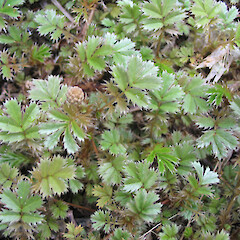Acaena anserinifolia
Common name
bidibid, hutiwai, piripiri
Synonyms
Acaena pusilla (Bitter) Allan var. pusilla, A. pusilla var. suprasericascens Bitter, Acaena viridior (Cockayne) Allan. The names A. anserinifolia var. sericeinitens (Bitter) Allan and var. paucidens, are referrable to A. profundeincisa (Bitter) B.Macmillan.
Family
Rosaceae
Flora category
Vascular – Native
Endemic taxon
Yes
Endemic genus
No
Endemic family
No
Structural class
Herbs - Dicotyledons other than Composites
NVS code
The National Vegetation Survey (NVS) Databank is a physical archive and electronic databank containing records of over 94,000 vegetation survey plots - including data from over 19,000 permanent plots. NVS maintains a standard set of species code abbreviations that correspond to standard scientific plant names from the Ngä Tipu o Aotearoa - New Zealand Plants database.
ACAANS
Chromosome number
2n = 42
Current conservation status
The conservation status of all known New Zealand vascular plant taxa at the rank of species and below were reassessed in 2017 using the New Zealand Threat Classification System (NZTCS) – more information about this can be found on the NZTCS website. This report includes a statistical summary and brief notes on changes since 2012 and replaces all previous NZTCS lists for vascular plants.
Please note, threat classifications are often suggested by authors when publications fall between NZTCS assessment periods – an interim threat classification status has not been assessed by the NZTCS panel.
- Conservation status of New Zealand indigenous vascular plants, 2017 . 2018. Peter J. de Lange, Jeremy R. Rolfe, John W. Barkla, Shannel P. Courtney, Paul D. Champion, Leon R. Perrie, Sarah M. Beadel, Kerry A. Ford, Ilse Breitwieser, Ines Schönberger, Rowan Hindmarsh-Walls, Peter B. Heenan and Kate Ladley. Department of Conservation. Source: NZTCS and licensed by DOC for reuse under the Creative Commons Attribution 4.0 International licence.
2017 | Not Threatened
Previous conservation statuses
2012 | Not Threatened
2009 | Not Threatened
2004 | Not Threatened
Distribution
Endemic. Found throughout the North Island, South Island, Stewart Island/Rakiura, and Chatham Islands. Naturalised on the Auckland Islands and Campbell Island/Motu Ihupuku.
Habitat
Abundant from lowland to lower subalpine forest margins and in shrublands.
Wetland plant indicator status rating
Information derived from the revised national wetland plant list prepared to assist councils in delineating and monitoring wetlands (Clarkson et al., 2021 Manaaki Whenua – Landcare Research Contract Report LC3975 for Hawke’s Bay Regional Council). The national plant list categorises plants by the extent to which they are found in wetlands and not ‘drylands’. The indicator status ratings are OBL (obligate wetland), FACW (facultative wetland), FAC (facultative), FACU (facultative upland), and UPL (obligate upland). If you have suggestions for the Wetland Indicator Status Rating, please contact: [Enable JavaScript to view protected content]
FACU: Facultative Upland
Occasionally is a hydrophyte but usually occurs in uplands (non-wetlands).
Detailed description
Stoloniferous, prostrate, trailing and perennial herb, forming diffuse to dense patches up to 1 m diam. Stems 1–1.5 mm diameter, prostrate stems < 1 m long, erect stems < 150 mm long (unless scrambling up through surrounding vegetation, in which case taller). Leaves 10–75 mm long, stipules 3–8-fid, leaflets 9–13, oblong, 4–17 × 2–9 mm, 7–15-toothed to base, dull green to yellow-green, basal leaves often mottled brown, upper surface sparsely to densely hairy, undersides paler, glaucescent to silvery, and very silky hairy, teeth tipped with a tuft of brush-like hairs. Inflorescence scape 40–120 mm long, covered in long, appressed hairs. Capitulum 5–8 mm diam. at flowering, 10–20 mm diam. (including spines) at fruiting; florets c. 50-60; sepals 4; stamens 2; anthers white or rose; style 1; white; achene 1. Fruit obconic, 3 × 12 mm, hairy, spines 4, pale brown, 4–9 mm long, barbed.
Similar taxa
Often grows with Acaena novae-zelandiae but can be recognised by the distinctive tuft of brush-like hairs surmounting the leaf teeth apices. Undersides of leaves are distinctly silvery due to dense covering of appressed silky hairs. Acaena juvenca and A. emittens are closely related. Both can be easily recognised by their very gracile, slender, stems, rather diffuse foliage, by the distal 3–5 leaflets obovate and larger than the basal leaflets, and by the usually entire stipules.
Flowering
October–January
Flower colours
Red/Pink, White
Fruiting
December–April
Life cycle
Spiny hypanthia are dispersed by attaching to fur, feathers and clothing and possibly also dispersed by wind and granivory (Thorsen et al., 2009).
Propagation technique
Easily grown from fresh seed and from rooted pieces.
Etymology
acaena: From the Greek ‘akanthos’ thorn, referring to the spiny calyx that many species have
anserinifolia: With leaves like Potentilla anserina
Attribution
Fact sheet prepared by P.J. de Lange for NZPCN (1 June 2013)
References and further reading
Thorsen MJ, Dickinson KJM, Seddon PJ. 2009. Seed dispersal systems in the New Zealand flora. Perspectives in Plant Ecology, Evolution and Systematics 11: 285–309. https://doi.org/10.1016/j.ppees.2009.06.001.
NZPCN Fact Sheet citation
Please cite as: de Lange, P.J. (Year at time of access): Acaena anserinifolia Fact Sheet (content continuously updated). New Zealand Plant Conservation Network. https://www.nzpcn.org.nz/flora/species/acaena-anserinifolia/ (Date website was queried)
















